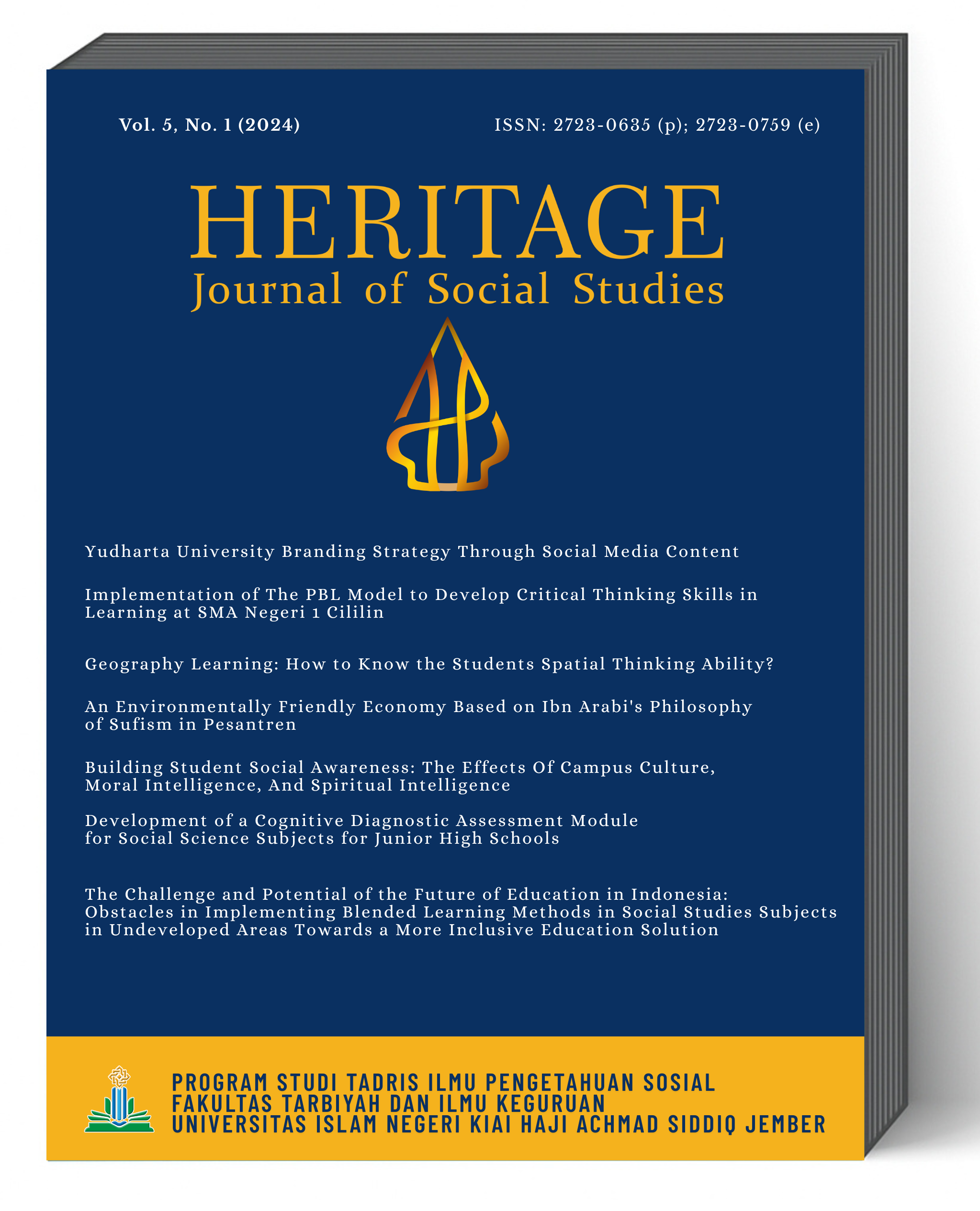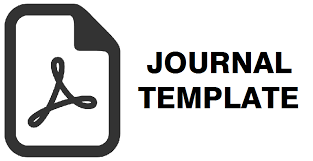Geography Learning: How to Know the Students Spatial Thinking Ability?
DOI:
https://doi.org/10.35719/hrtg.v5i1.133Keywords:
Geography Learning, Spatial Thinking, Students Spatial AbilityAbstract
This research aims to develop an instrument for students' spatial thinking abilities in geography learning. This research uses the ADDIE Research and Development model method. The research subjects were 24 students of class XII IPS 2 at SMA Negeri 1 Kandanghaur, Indonesia. The instrument used is a multiples choice test consisting of six closed questions related to material on rural and urban spatial interactions in geography learning. The indicators developed in preparing the questions are related to spatial thinking skills, namely village and city spatial patterns linked to local regional space, case studies in one's own region, and forms of implementation of spatial interactions. The various questions are prepared first and then expert judgment is carried out. The next step is to test validity, reliability, difficulty index and distinguishing power index. Validity test analysis shows that the six items in the instrument are valid and the reliability of the test instrument is categorized as sufficient. Meanwhile, the level of difficulty is categorized as easy and medium, and the ability to differentiate the questions is included in the good criteria. Thus, the six question items developed can be applied as instruments to measure spatial thinking abilities.
References
Aksa, F. I., Utaya, S., & Bachri, S. (2019). Geografi dalam Perspektif Filsafat Ilmu. Majalah Geografi Indonesia, 43-47. https://doi.org/10.22146/mgi.35682.
Aliman, M., Halek, D. H., Lukman, S., Marni, S., & Alnursa, D. S. (2022). Apakah Model Earthcomm dan Gaya Belajar dapat Mempengaruhi Kemampuan Berpikir Spasial Siswa SMA? Jambura Geo Education Journal, 114-125. https://doi.org/10.34312/jgej.v3i2.16348.
Aliman, M., Mutia, T., Halek, D. H., Hasanah, R., & Muhammad, H. H. (2020). Pengembangan Instrumen Tes Kemampuan Berpikir Spasial Bagi Siswa SMA. Geodika: Jurnal Kajian Ilmu dan Pendidikan Geografi, 1-10. https://doi.org/10.29408/geodika.v4i1.1823.
Amelia, F., Ruja, I. N., & Susilo, S. (2018). Makna Rendahnya Motivasi Siswa Belajar Geografi dalam Pendekatan Fenomenologi. Jurnal Pendidikan: Teori, Penelitian, dan Pengembangan, 1244-1252. http://dx.doi.org/10.17977/jptpp.v3i9.11585.
Asiyah, S., & Rosita, L. (2019). Characteristics of Spatial Capability of Geographic Students of PGRI Palembang University. GeoEco Journal, 192-200. https://doi.org/10.20961/ge.v5i2.35624.
Bednarz, R., & Lee, J. (2019). What improves spatial thinking? Evidence from the Spatial Thinking Abilities Test. International Research in Geographical and Environmental Education, 262-280. http://dx.doi.org/10.1080/10382046.2019.1626124.
Bolarinwa, O. A. (2015). Principles and Methods of Validity and Reliability Testing of Questionnaires Used in Social and Health Science Researchers . Nigerian Postgraduate Medical Journal, 195-201. https://doi.org/10.4103/1117-1936.173959.
Brownstein, N. C., Louis, T. A., O’Hagan, A., & Pendergast, J. (2019). The Role of Expert Judgment in Statistical Inference and Evidence-Based Decision-Making. The American Statistician, 56-68. https://doi.org/10.1080/00031305.2018.1529623.
Chang, C. H., & Kidman, G. (2019). Curriculum, Pedagogy and Assessment in Geographical Education – For Whom and For What Purpose? International Research in Geographical and Environmental Education, 1-4. https://doi.org/10.1080/10382046.2019.1578526.
Creswell, J. W. (2019). Research Design: Pendekatan Model Kualitatif, Kuantitatif, dan Campuran. Yogyakarta: Pustaka Pelajar.
Daldjoeni. (2014). Pengantar Geografi. Yogyakarta: Penerbit Ombak.
Fatimah, L. U., & Alfath, K. (2019). Analisis Kesukaran Soal, Daya Pembeda dan Fungsi Distraktor. Al-Manar, 37-64. http://dx.doi.org/10.36668/jal.v8i2.115.
Hadi, S. (2016). Metodologi Riset. Yogyakarta: Pustaka Pelajar.
Herdlein, R., & Zurner, E. (2015). Student Satisfaction, Needs, and Learning Outcomes: A Case Study Approach at a European University. Sage Journal, 1-10. https://doi.org/10.1177/2158244015580373.
Hibatullah, I. N., Susanto, & Monalisa, L. A. (2020). Profil Kemampuan Spasial Siswa Ditinjau dari Tipe Kepribadian Florence Littauer. Jurnal Pendidikan Matematika dan Matematika, 115-124. https://dx.doi.org/10.24853/fbc.6.2.115-124.
Li, X., Li, H., Zhang, Y., & Yang, L. (2017). Spatial Patterns and the Regional Differences of Rural Settlements in Jilin Province, China. Sustainability, 1-16. https://doi.org/10.3390/su9122170.
Maryani, E. (2022). Geografi di Era Digital. Bandung: Jendela Hasanah.
McLaughlin, J. A., & Bailey, J. M. (2023). Students Need More Practice with Spatial Thinking in Geoscience Education: a Systematic Review of the Literature. Studies in Science Education, 147-204. https://doi.org/10.1080/03057267.2022.2029305.
Meadows, M. E. (2020). Geography Education for Sustainable Development. Geography and Sustainability, 88-92. https://doi.org/10.1016/j.geosus.2020.02.001.
Metoyer, S. K., Bednarz, S. W., & Bednarz, R. S. (2015). Spatial Thinking in Education: Concepts, Development, and Assessment. In O. M. Solari, A. Demirci, & J. v. Schee, Geospatial Technologies and Geography Education in a Changing World. Tokyo: Springer. https://doi.org/10.1007/978-4-431-55519-3_3.
Nazareth, A., Newcombe, N. S., Shipley, T. F., Velazquez, M., & Weisberg, S. M. (2019). Beyond Small-Scale Spatial Skills: Navigation Skills and Geoscience Education. Cognitive Research: Principles and Implications, 1-17. https://doi.org/10.1186/s41235-019-0167-2.
Novrizal, A., Rushayati, S. B., & Wijayanto, H. (2019). Peran Pembelajaran Geografi dalam Pembentukan Pengetahuan dan Sikap Pelestarian Lingkungan Hidup pada Siswa SMA . SOSIO DIDAKTIKA: Social Science Education Journal, 65-74. https://doi.org/10.15408/sd.v6i1.11256.
Nugraha, Y. K., & Santosa, P. B. (2022). Influence of Spatial Abilities on Spatial Data Quality in Participatory Mapping. Indonesian Journal of Geography, 185-194. https://doi.org/10.22146/ijg.64931.
Nurulhasni, D., Nurbaiti, E. A., Nabila, R. S., & Jumadi. (2023). Developing and implementing an instrument for assessing critical thinking and visual representations in learning Physics materials of Optical Instruments. Jurnal Penelitian dan Evaluasi Pendidikan, 52-62. https://doi.org/10.21831/pep.v27il.53550.
Peterson, E. G., Weinberger, A. B., Uttal, D. H., Kolvoord, B., & Green, A. E. (2020). Spatial Activity Participation in Childhood and Adolescence: Consistency and Relations to Spatial Thinking in Adolescence. Cognitive Research: Principles and Implications, 1-13. https://doi.org/10.1186/s41235-020-00239-0.
Putri, H. E., Pertiwi, C. K., Arrum, A. H., Nurhanifa, R., & Yuliyanto, A. (2021). Mathematical Connection Ability Instrument for Primary Schools Students. Auladuna: Jurnal Pendidikan Dasar Islam, 1-19. https://doi.org/10.24252/auladuna.v8i1a1.2021.
Rahmanelli, & Prarikeslan, W. (2019). Spatial Thinking Analysis of Geographic Students Based on Lesson Study for Learning Community in Geographic Learning . Sumatra Journal of Disaster, Geography and Geography Education, 159-164. https://doi.org/10.24036/SJDGGE.V3I2.264.
Silviariza, W. Y., Sumarmi, & Handoyo, B. (2021). Improving Critical Thinking Skills of Geography Students with Spatial Problem Based Learning (SPBL). International Journal of Instruction, 133-152. https://doi.org/10.29333/iji.2021.1438a.
Soeharto, & Csapó, B. (2021). Evaluating item difficulty patterns for assessing student misconceptions in science across physics, chemistry, and biology concepts. Heliyon, 1-13. https://doi.org/10.1016/j.heliyon.2021.e08352.
Somantri, L. (2022). Indonesian Spatial Intelligence for Geography Teachers. Jurnal Penelitian Pendidikan Indonesia, 267-274. https://doi.org/10.29210/020221355.
Sugiyono. (2017). Metode Penelitian dan Pengembangan. Bandung: Penerbit Alfabeta.
Suharyono, & Amien, M. (2013). Pengantar Filsafat Geografi. Yogyakarta: Penerbit Ombak.
Susetyo, B. (2017). Statistika untuk Analisis Data Penelitian . Bandung: Refika Aditama.
Utsman, F. R. (2015). Panduan Statistika Pendidikan. Yogyakarta: Diva Press.
Downloads
Published
How to Cite
Issue
Section
License
Copyright (c) 2025 heritage

This work is licensed under a Creative Commons Attribution-ShareAlike 4.0 International License.





